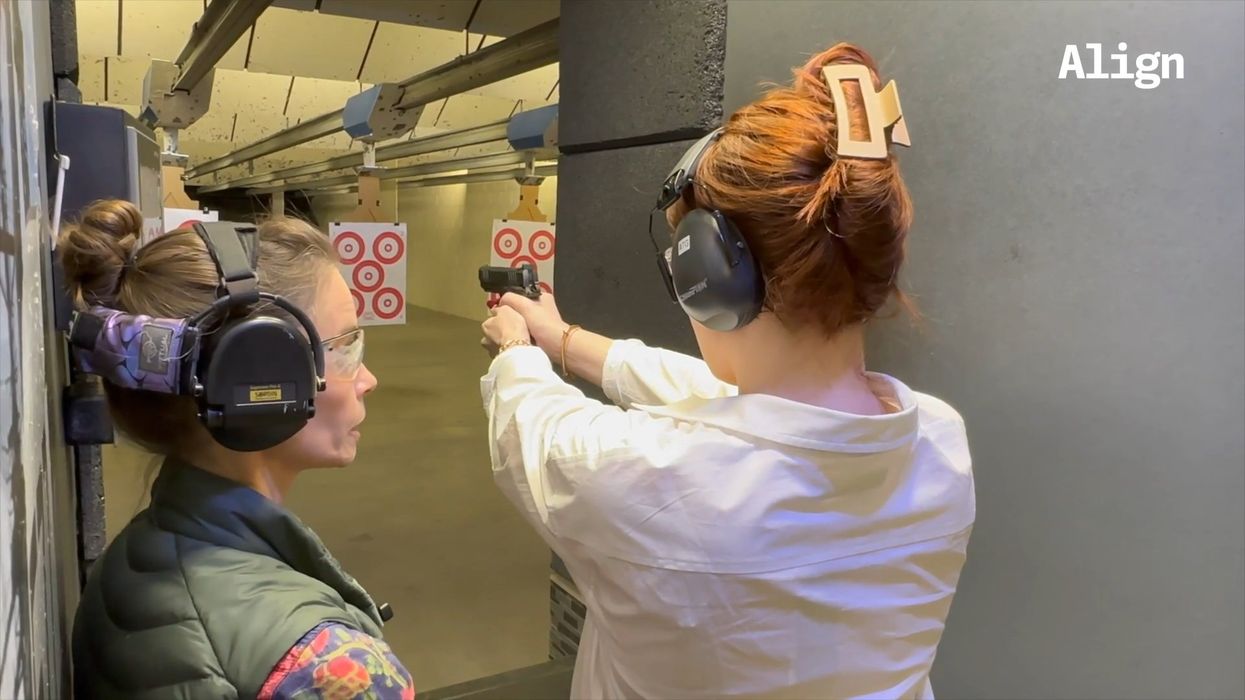
Matt Himes

The founder of Dallas-based Aim True tells Align what every woman new to guns needs to know.
Note: for further discussion of "fully automatic" AR-15s, see later in the article.
There’s something about firing an AR-15 on full auto that puts a big smile on your face.
At least it does for my colleague, Helen Roy. It’s also addictive, apparently; no sooner has she emptied the entire magazine into the target than she asks, “Is that all?”
'A lot of the ladies that do come on a regular basis call it "lead therapy," because while you're out there, you're going to feel all this energy hitting you, and then you just want more of it.'
Behind her, David Prince laughs knowingly. A tall, grandfatherly former CPA, Mr. Prince (as everybody calls him) owns the spacious and immaculate Eagle Gun Range, where we’ve just spent the last few hours getting a crash course in how to shoot.
Beaming next to him with almost maternal pride is Helen's instructor, Anna Thomasson. She — along with her husband, Bryan Wertz — has been kind enough to spend the afternoon giving us a highly condensed version of the extensive firearms training she offers women through her company, Dallas-based Aim True.
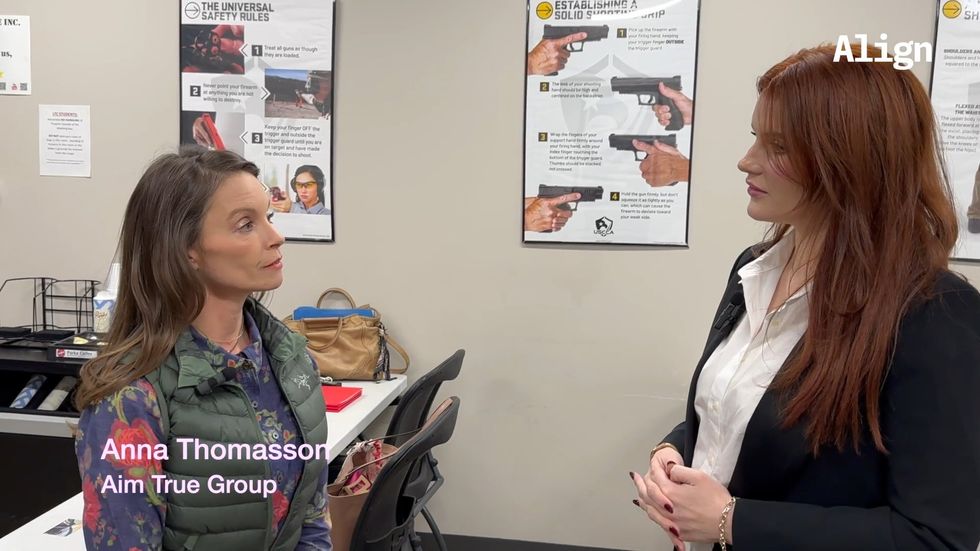
Although Thomasson grew up around firearms, she was always more observer than participant. "My family is very traditional,” the petite Texan explains. “My dad is ‘boys shoot guns and girls stay in the kitchen.'”
That changed in 2015, when Thomasson was diagnosed with breast cancer. Her husband, Bryan Wertz, was a lifelong avid shooter; during her recovery he suggested she join him at the range as a way to spend time together while getting outside and getting some sun.
Thomasson found she enjoyed it. And not only that — learning to handle a firearm seemed to restore some of the inner strength sapped by her medical ordeal. “I got the feeling I could be confident in the world again,” she says.
She never looked back, taking course after course and honing her skills. She formed Aim True in 2017 as way to teach firearm self-defense to other women. She also organized the “ladies-only” training group Diamonds and Derringers.
Like Thomasson, Helen has always been comfortable around guns. Her father and her older brother (military veteran and active military, respectively) both enjoy shooting, as does her husband. While she's often joined them at the range and has fired off a few shots of her own on occasion, she's never gotten much, if any, formal training. She's here to rectify that. Helen tells Thomasson she should consider her a beginner.
We start in a tidy, well-lit classroom tucked away near Eagle Gun Range’s front desk. When I ask how they met, Wertz and Thomasson smile as they describe their courtship, more or less finishing each other’s sentences.
There’s an ease between them that automatically puts us at ease, and it sets the tone for the hours to come. As Thomasson runs the training, Wertz sits to the side, doing work on a computer, every so often interjecting to expand or emphasize a point Anna makes.
Thomasson begins by explaining what’s different about firearms training for women.
To begin with, says Thomasson, many of her students are motivated by a newfound sense of vulnerability.
“I have a lot of clients coming to me when they’ve had a divorce, or they’ve lost their spouse, or they’ve had a break-in at their home,” she says. “They’ve never wanted to hold a gun before, they've never had any interest in it, and now a situation has dictated that this is something [they] have to do.”
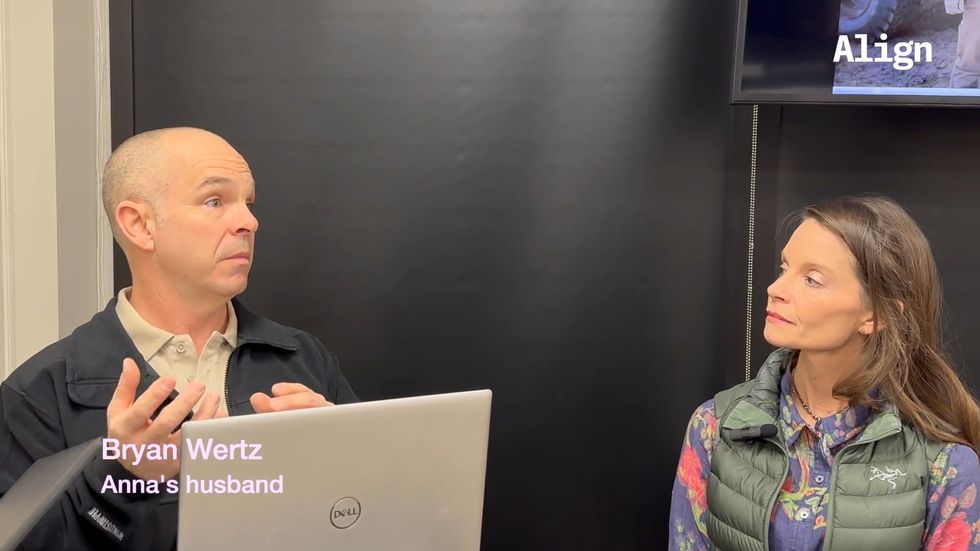
According to Wertz, this reluctance tends to make women who do show up for the course very diligent students.
“We always say that a man feels like he was born to stick a gun in his pants and walk around with it,” says Wertz. A woman, on the other hand, “says I really want to know about this gun and I want to make sure that I don't hurt someone with it, that someone doesn't hurt me with it, that I really understand all aspects of it and how to use it and be confident.”
When that confidence finally comes, it’s often a revelation, says Thomasson. “Sometimes they have an emotional reaction to shooting the first time. And sometimes it just goes straight into, oh my gosh, I am going to be able to take care of myself and I don't have to rely on anybody else.”
When it comes to buying a gun, Thomasson likes to start with an often overlooked question: Can you find a holster for it? “My clients go to Highland Park Village, get a really pretty gun, and I say, ‘And you can leave it on your bedside table because there's no holster to fit it,’” says Thomasson.
Unless you’re planning to use your gun exclusively out in the country, Thomasson recommends a concealed-carry holster, typically worn inside the waistband.
“Our hands are different from men's,” notes Thomasson. “They're usually a little bit smaller.”
That doesn’t necessarily mean you want a smaller gun, but rather a “grip size that we can actually reach the trigger on.”
Ultimately, says Thomasson, how a gun fits your hand can come down to personal preference. She likens choosing a gun to buying shoes. “I can't buy you a pair of shoes and say, ‘Love these shoes. You should wear them.’ But [I can] teach you the aspects of the gun and what you should be looking for.”
One common misconception Thomasson encounters is the assumption that a smaller gun will always be easier to shoot.
“This is our mindset as women. We think the bigger the gun, the harder it is to control, and the smaller the gun, the easier it is to control.”
Thomasson recalls a recent exchange with a client.
“[A woman] in her 70s called and she said, ‘I'm about five foot tall and I don't have much strength. I have a really big gun, a 9mm, and I think I want to sell it and have you teach me how to use a smaller gun.’”
Thomasson quickly got her to reconsider. “I talked to her about the recoil … and the weight of that bigger gun taking some of that recoil away from your hands and your shoulders. Whereas a smaller gun doesn't have the weight to [absorb] that recoil … and it ends up hitting you harder.”
For Thomasson, this is an essential part of the training she offers: “learn[ing] how to figure out what kind of gun is going to suit you best for your hand strength … [and] your situation.”
Thomasson leads us over to a table on which she’s placed a Glock semiautomatic pistol with a special slide for training as well as a pile of inert dummy rounds — in this case, spent UTM training blank cartridges. She begins by teaching Helen to load the magazine, which she recommends bracing against the tabletop.
Laughing at how surprisingly difficult she finds it, Helen says, “You know what, this is very important. How do you do gun stuff and maintain a manicure?”
Thomasson has anticipated the question. “You know there's always a girl way and a boy way,” she says, fetching a small device from a nearby shelf and handing it to Helen. It’s called an UpLULA, and before long it significantly increases Helen’s efficiency.
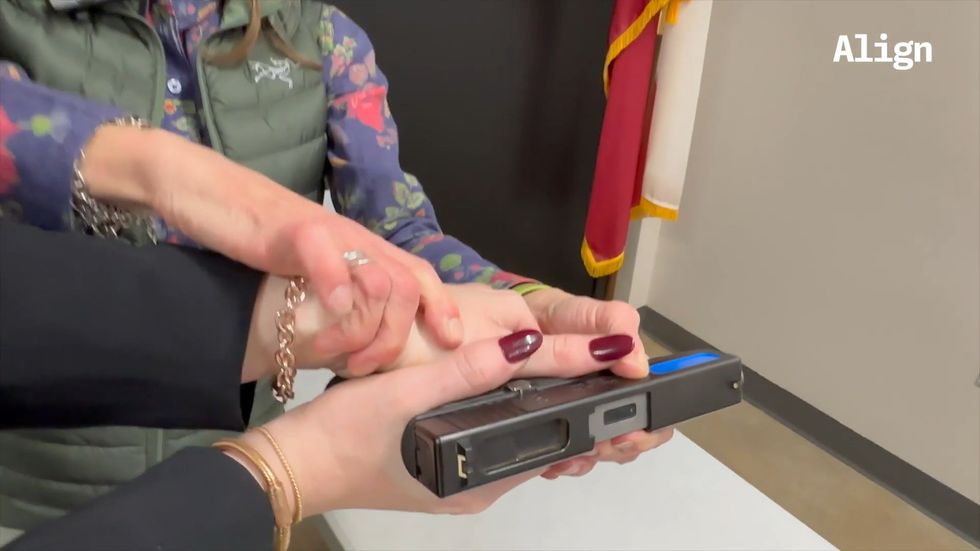
Now that the gun is loaded, it’s time to pick it up. But first Thomasson imparts a basic principle of gun safety: “[You] don't ever want to touch the trigger until [you’re] ready to touch the trigger.”
“This gun is developed to be comfortable in your hand when your finger is on the trigger,” explains Thomasson. “So that's the way that your hand is going to want to pick this up.”
To avoid this, says Thomasson, we have to force ourselves to rest our finger on the frame as we grab the rest of the gun with our hand.
Thomasson points to the fleshy webbing between Helen’s index finger and thumb. “When you pick this gun up … I want you to see how high you can get this part of your hand up here,” she says, indicating the curved little overhang separating the top of the grip from the rest of the pistol.
Helen does, which gives Thomasson the chance to point out an important physiological difference between men and women. “Now if I had one of the boys pick this up, then all of the meat [between his thumb and index finger] would be squished up at the top. But females don't have that kind of muscular development in that part of our hand.”
It’s a difference that can often be overlooked, says Thomasson. “A male instructor will tell the female you need a higher grip, you need a stronger grip. And the lady says, ‘This is all the grip I've got. I don't have any more hand.’”
It's something neither of us have ever thought about, apparently. "It's almost as if men and women are different," marvels Helen with mock incredulity. She examines my hand and compares it to hers.
"I do have that space," she says, smiling brightly. "Confirmed woman!"
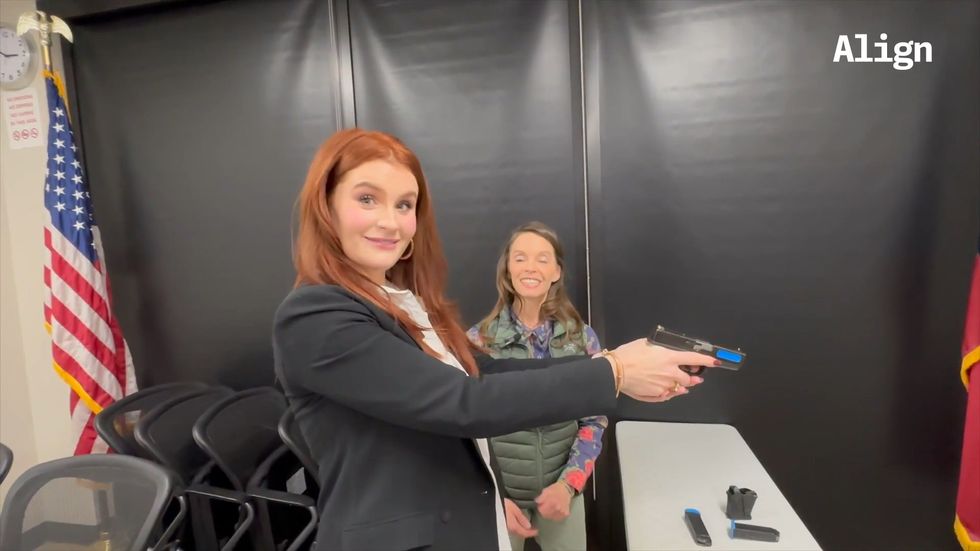
When it comes to finding a properly fitting gun, Thomasson says it’s all about how your finger reaches the trigger. You want to have it close enough that you comfortably pull it back, without it being so close that your finger wraps around to the other side.
After teaching Helen how to complete the grip with the placement of her non-shooting hand, as well as how to use the pistol’s metal sight, Thomasson talks proper stance.
“Did you notice that you leaned back?” she asks Helen. “The minute you picked up that gun, you got away from it.”
Thomasson says this is an unconscious expression of fear — “we think the gun is going to go off and cause a big bang and we’re already scared of it.” This is precisely what her training seeks to overcome.
After Thomasson advises Helen on the proper stance, it’s time to dry fire — that is, “shoot” the gun without any live ammunition. We all know it’s loaded with inert rounds, but as Helen aims, the tension in the room builds, and when the hammer makes its quiet little “click,” there’s a tangible sense of release.
Helen lets out a deep exhale and smiles. She looks a little flushed.
“What went through your mind?” asks Thomasson gently.
“Something about having bullets in the gun made me a little nervous,” says Helen. “It's weird, there's so much psychological stuff built up around guns. And I have shot guns before, but ...”
“Because you loaded this and you made that action happen,” says Thomasson. She puts her hand on Helen’s shoulder. “How are you doing?”
“I'm good. It's kind of powerful, though. Do women often have an emotional reaction when they shoot?”
“I would say 75% of the females that I have, the first shot they go into tears. We put the gun down and we step back and we hug and we talk about it for five or ten minutes. A lot of the ladies that do come on a regular basis call it ‘lead therapy,’ because while you're out there, you're going to feel all this energy hitting you, and then you just want more of it.”
At this point Bryan chimes in to emphasize the power of a good grip.
“So a lot of times, ladies will ask Anna, you know, should I have a gun because I'm tiny and a man will take it from me?”
He demonstrates by trying to pull the gun out of Helen’s hands. He can’t. “I'm just not going to get it from you before you could use your blaster.”
He then addresses how to hold the gun before you’re ready to point and shoot; for example, if you’re preparing to defend yourself against what could be an intruder in your house. In this case, says Wertz, its best to hold the gun pointed down toward the floor.
He demonstrates on Helen. If she holds her gun above her head, pointed toward the ceiling, it’s easy for him to keep her from bringing the gun level.
Wertz then shows what happens if he grabs Helen’s gun when it's pointed to the floor. “If you kneel, then what am I giving you? I’m giving you the perfect first shot.”
David Prince is old enough to have had an entire career before this one, but he radiates boyish enthusiasm when he talks about Eagle Gun Range.
He opened it in 2012, after noticing that there hadn’t been a range built in the Dallas area for 30 years.
“My wife's inspiration is my perspiration,” he jokes. After building a fence and a rock garden, among other projects, they decided to think bigger. “Let us build a gun range. … I can do that.”
“We wanted someplace [that was] really family-friendly,” Prince says. “Especially friendly to the mothers and the women, because stereotypically, women and guns don't mix. … We wanted a place for them to come and feel safe.”
A big component of Eagle Gun Range’s family-friendly atmosphere is its state-of-the-art air filtration system, which removes the contaminants produced by firearm discharge. “It’s cleaner in the range than it is outside,” says Prince.
It’s clear that he’s proud of what he’s created. “Our mission statement says it all: to have a place that's safe and fun to shoot.”
And it’s not that he’s pandering to the ladies, either.
“Indoor shooting is a great co-ed sport,” he says. “Women outshoot guys all the time. Women are great shooters. It’s a fun sport. It doesn't take massive muscles. You can do it and compete against each other, and it's a fun thing, especially for families. Kids get to shoot against the parents. It’s something the whole family can enjoy.”
Now it's time for Helen to put her classroom training into practice.
We head to the private bay Prince has graciously arranged for us, and Thomasson introduces Helen to the first gun she'll be shooting. It's a Glock 9mm, the same as the practice gun she used. Only this one, of course, shoots real bullets.
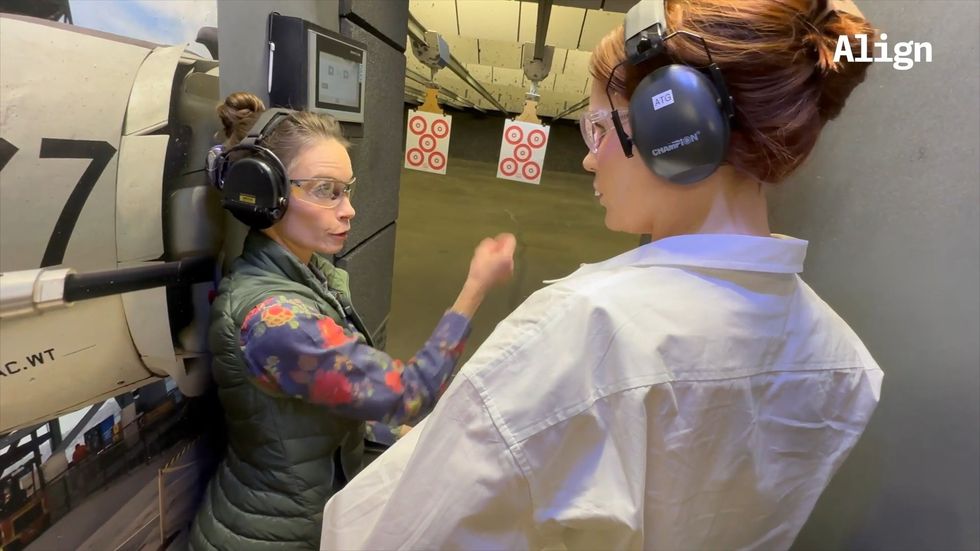
Helen loads the magazine, sorts out her grip, and gets into her stance. She aligns her sights at the paper target, then finds the trigger. She takes a deep breath and very slowly pulls it back.
Bang. We all exhale. Helen smiles. "There we go. That was fun."
It was a decent shot, hitting the human silhouette just above the bull's-eye over the chest. Helen fires off another. This one still hits the target, but a little wide. Thomasson reminds her to take it slow.
"When you pull it really fast, you kind of jerk the gun down, and then that's when you end up with shots that are not in the target. Not that, if you were defending yourself, it still wouldn't hurt the person. But if we want to get that perfect shot, [we need] control of the trigger."
Thomasson then has Helen shoot the same cartridge in a smaller gun: a subcompact Glock in turquoise. This gun's grip is significantly thinner and shorter than the previous one; Helen's pinky just barely wraps around the bottom.
When she shoots, the kick is powerful enough that her left hand slips off a little. Helen also notices that because the gun's size allows her finger to wrap all the way around the trigger, it has a tendency to pull to the right when shooting.
It's all a vivid demonstration of Thomasson's earlier point about women and gun size. "[They] say shrink it and pink it and that's how you sell it to a woman," says Wertz. "Well, that's no good because then it's just a pink gun and it's tiny."
As an alternative, Thomasson shows us the Walther PDP F-Series, a full-size 9mm pistol designed for shooters with smaller hands. To get the gun's ergonomics and fit just right, Walther consulted with expert female shooters, including Olympian Gabby Franco.
Noting that the training so far has used Austrian and German pistols, I ask Wertz about the American gun industry.
"When we get into rifles, bolt-action rifles, semiautomatic rifles, carbines, we win," says Wertz, "but the Europeans kind of have a hold on the striker-fired market. The polymer lower, steel upper type gun like Glock, Sig, H&K, Walther, all really great handgun manufacturing companies."
Wertz is quick to add that Smith & Wesson does make an excellent striker-fired pistol that many competitors use.
Of course, the iconic American brand has other claims to fame. "Smith & Wesson makes a better revolver than anybody in the world," says Wertz. "And then if you want a 1911-style, old kind of World War II Heritage American pistol, nobody makes them better than we do."
In this latter category, Wertz singles out Florence, Texas-based Staccato. "Anna's got a Staccato that she carries a lot, and they make a better gun than than just about anybody else."
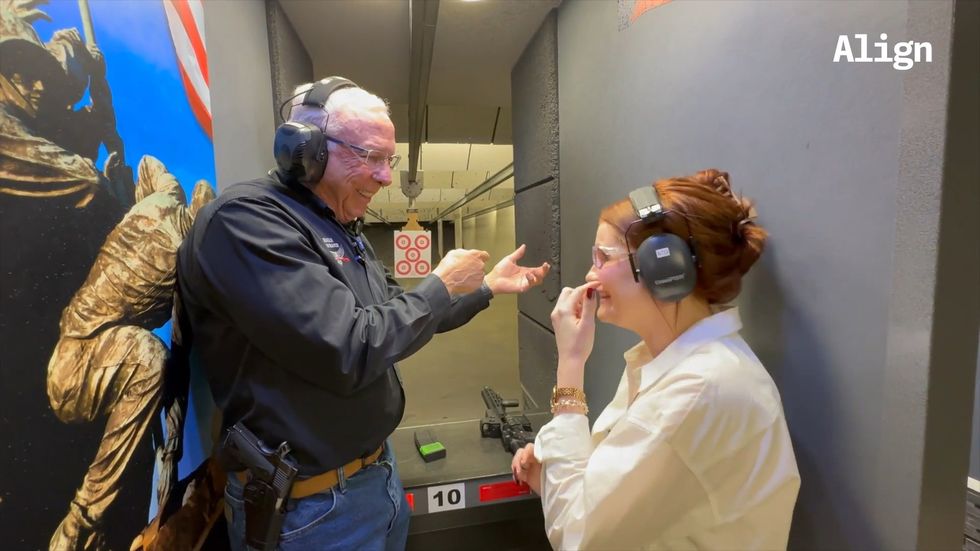
According to Prince, Helen is something of a natural. He pulls her target and examines it with admiration. "This is extremely good shooting. She's at five yards, but she shot with several firearms, not having any practice rounds."
Helen does equally well on the semi-automatic AR-15 rifle Prince offers her; in fact, she finds it to be her favorite firearm of the day. "I feel so much more confident with [the AR-15] than the smaller ones," she says, when asked if she'd rather have it or a pistol for self-defense.
Wertz says that despite the media's relentless propaganda about "assault rifles," this is a common reaction from women after they shoot an AR-15. "You can see how accurate you were with very little effort and without having any training."
Then it's time to try the rifle on full auto.
*Note: There is no vehicle for the purchase of a fully automatic AR-15 available to the average US citizen. Eagle Gun Range has the proper federal license required to own and operate the rifle that Helen shot that day.
Prince is thorough and professional as he coaches Helen on what to expect; at the same time, you can tell he can't wait for her to let it rip. "It's just natural — when you first squeeze the trigger, you're going to let it rattle off about five rounds. You're going to let go. We're going to reload. Squeeze. Turn around and smile."
Just before Helen pulls the trigger, Wertz smiles. "It's gonna get sporty."
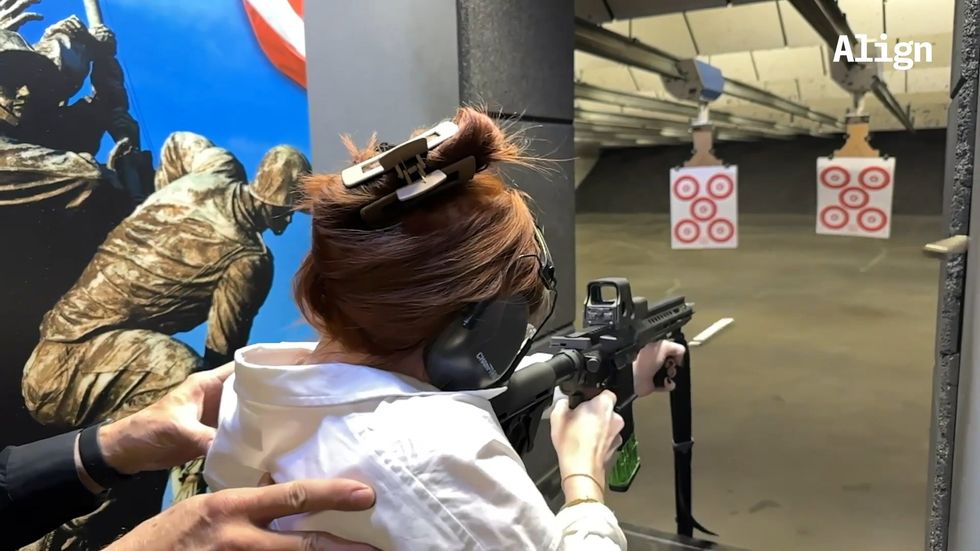
To watch some of Helen's training with Aim True at Eagle Gun Range, check out the video below.
For more information about Aim True and the wide variety of firearms and emergency preparedness training it offers, see here.
To learn more about Eagle Gun Range or to explore its online store, go here.